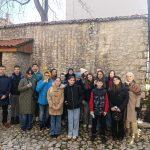In addition to its thematic collections, the Museum of Sarajevo also boasts a rich photo library. Even before the Museum was officially founded in 1949, the Commission for Culture and Art of the City of Sarajevo tasked Professor Vojislav Bogičević, the first manager of the Museum, with collecting material. This effort yielded swift results, and by the Museum's inception, a small but significant photo collection had already been established.
Over the ensuing years, efforts to expand this collection intensified. Alongside other museological materials, a substantial number of photographs were acquired. By 1963, the photo library had grown to include 2,522 inventory numbers encompassing 8,798 photographs. These were categorized as follows: 867 related to the Art Collection, 1,398 to the Archaeological Collection, 177 to the Oriental Collection, and 17 to various albums. The remaining 5,000 photographs documented the Sarajevo assassination, the labor movement and NOB (National Liberation War), and the cultural history of Sarajevo. By 1974, in celebration of the Museum's twenty-fifth anniversary, the photo library had amassed over 10,000 photographs, thanks in large part to the efforts of Ivan Tometinović, the Museum's preparator since 1951, who took and developed many of the photographs. A certain number of the photographs, a large number of which were created before the foundation of the Museum, was collected through purchase and cooperation with other cultural institutions or individuals who provided their negatives, duplicates or originals.
Today, the photo library boasts 9,037 inventory numbers with more than 15,000 photos, primarily black and white, along with negatives, slides, old stationery, and postcards. The photo library is thematically organized into several fund groups based on content, time, and place of creation. The largest portion of the collection originates from Sarajevo and its immediate surroundings, although some photographs depict scenes from other cities and towns in Bosnia and Herzegovina. The oldest photographs date back to the late nineteenth century, thus spanning a timeline from the end of the nineteenth century to the present day. Thus the photo lybrary's extensive time span preserves a wealth of visual data on the life, work, and culture of Sarajevo and Bosnia and Herzegovina over the last two centuries.
In addition to photographs taken by Museum employees and collaborators since its establishment, the collection includes works by notable authors and collectors such as Alija Bejtić, Kosta Mandić, and Stojan Petrović. The collection features images of everyday life, various buildings, and cultural and historical monuments, offering a continuous visual narrative of the people's work, life and region's development within a wide time span. Consequently, the photographs in this collection are invaluable to historians, art historians, archaeologists, anthropologists, ethnologists, urban planners, architects, and anyone interested in the social history of Sarajevo and Bosnia and Herzegovina.



